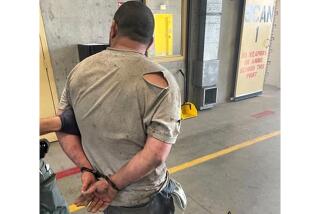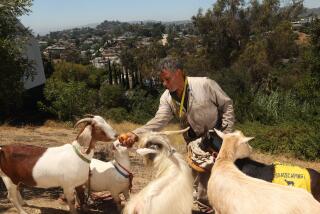DODGING A BULLET : Weinberger Orders a Last-Minute Stay of Execution for 1,200 Goats on San Clemente Island
- Share via
Defense Secretary Caspar W. Weinberger ordered a stay of execution Thursday for more than 1,200 wild goats on San Clemente Island, less than 24 hours before helicopter-borne sharpshooters were scheduled to start killing the animals.
In a two-sentence statement issued at the Pentagon, Weinberger said that, after discussions with Rep. Bobbi Fiedler (R-Northridge), he had agreed to delay the slaughter until the end of February. The shooting had been scheduled to begin this morning but the delay will give animal protectionists a new chance to trap and remove the goats from the island, which is owned by the federal government and is used by the U.S. Navy for bombing and shelling practice.
Weinberger’s announcement came after Fiedler and Cleveland Amory, head of the international Fund for Animals, had been rebuffed by high Navy officials in Washington when they sought to have the shooting called off in favor of the trapping program.
“It was a miracle when, several hours later, I got a call telling me of Weinberger’s action,” Amory said in a telephone interview. “I had written to him about the matter previously and (Fiedler) evidently had reached him some time late today.”
Will Resume Trapping
Amory said the trapping program, similar to ones carried out in 1983 and again last summer that resulted in the capture of more than 1,000 goats, will be resumed “as soon as possible, maybe before the end of this month.”
Weinberger’s statement said he had delayed the shooting “in order to enable . . . the Fund for Animals to remove from the island as many goats as possible.
“We are still obligated to comply with the laws of California and the directives of the Department of the Interior to eventually eliminate the goat population from the island because they are destroying flora and fauna which are native to the island,” the statement added.
For more than a decade, the feral goats on San Clemente Island, believed to be descendants of animals left behind by seamen as long as 200 years ago to provide food for passing ships, have been shot and trapped in an effort to wipe them out. Navy biologists say the goats are destroying the habitats of several plants, two species of lizard and one bird that are unique to the island and are on the federal endangered species list.
Fiedler said that during Thursday’s meeting with Vice Adm. Thomas Hughes, deputy chief of naval operations, she suggested delaying the shooting program 30 to 45 days and using half the $95,000 earmarked for the project to capture as many goats as possible.
When that idea was rebuffed, Fiedler said, she took steps to appeal to Weinberger.
“I told his representative that ours was a reasonable proposal that could be implemented quickly enough to resolve the issue as far as the Navy is concerned,” she said. “Weinberger agreed. I was really surprised, particularly because they did not ask to make substantial changes or fine-tune it.
Amory said he would be in immediate contact with Bill Hales, of New Zealand, who has developed a method of capturing goats in nets fired from a helicopter. Hales conducted the rescue operations in 1983 and 1984, when about 1,200 animals were caught and taken to a Fund for Animals ranch in Texas, where they were offered for adoption.
Meanwhile, Ken Mitchell, spokesman at the North Island Naval Air Station in Coronado, Calif., said an animal control expert, Steve Carothers, was on his way from Flagstaff, Ariz., expecting to start the shooting program today under Navy contract.
Also contributing to this story were Times staff writers James Gerstenzang in Washington and Gary Jarlson in Orange County.
More to Read
Sign up for Essential California
The most important California stories and recommendations in your inbox every morning.
You may occasionally receive promotional content from the Los Angeles Times.













